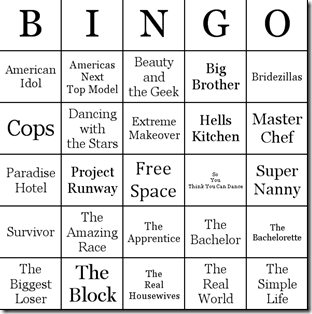I begin this with an obvious fact. Reality TV has invaded nearly every facet of American TV networks. This change is driven by the massive changes in the advertising world but the end result will be the complete transformation of the television industry as we know it. It’s not something coming in the next decade – it’s already begun.
I began writing this story after tweeting this:


This is the new face of History Channel:
A La Carte TV Programming Coming?
In the near future, network and basic cable TV channels will have nothing but the cheapest programming available to them. That means realityTV programming known in the industry as unscripted television and lower-tier sports. The rest will be reruns of older tv series or older programming from pay channels. If you’re one of those who has been anxiously waiting for the A La Carte programming where you decide which channels you get with cable or satellite TV, well you’re going to get something close to that. But you might not like it once you realize what it means.
1999 – It Begins
Around 1999 and 2000, American TV watched the success of unscripted shows like Big Brother and Survivor. The late-night talk show hosts liked to make fun of these shows, but it was very obvious that many were watching these shows – in numbers that were large enough that networks realized this could be a gold mine. Inexpensive production, no money to pay stars, and the fact that these were treated like “live” events made audiences watch it as it aired instead of “DVR’ing” them like they were doing with many of the other series. Then in 2001 ratings dropped. Network executives and press began saying it was a passing fad that would eventually dwindle. But they didn’t dwindle. The number of realityTV shows continued to slowly increase in the 2000s.
RealityTV Multiplies in 2007
Fast forward to the writers strike in 2007. Network executives and programmers literally had thousands of television hours to fill and no new scripted shows to fill that time with. An easy answer for the executives was to ramp up reality series and fill the void. No actors or writers to deal with during the strike and they were cheap to produce. Add in the fact that TV audiences had nothing else to watch either and you have the perfect storm. The strike was finally resolved in early 2008, but rumblings of a Screen Actor’s Guild strike kept the industry hesitant to commit to very many new scripted shows for another year.
This time allowed for reality TV programming to take hold. Network executives came to the realization that while the quality of the programming took a serious hit, the profit from these shows many times INCREASED the advertising revenue because more people were watching these shows live.
Fast Forward to 2012: RealityTV is Everywhere
If you watch much TV you already know this. But I’ll point out the obvious and show how much unscripted TV has taken over. Doing a simple search for reality programming on Monday, February 6th from 7pm EST through 10pm EST and you will find more than 70 airings of reality TV programs across the networks (cable and major networks). And it’s all over the channels, not just Spike and TruTV. You find things like Paranormal State on Biography, Pawn Stars on History, Hoarding: Buried Alive on TLC, World’s Strictest Parents on CMT, Supernanny on Style, Keeping Up With the Kardashians on E, and The Bachelor on ABC.
This is just a small sampling of shows on TV these days. The History Channel is no longer about… well about history. Instead primetime this week on the History Channel you will find the following: Pawn Stars, Cajun Pawn Stars, American Restoration, Swamp People, Mudcats, Top Gear and American Pickers. Not a single history-centric airing on the channel they call “History Channel.”
Move on to the channel formerly known as SciFi, now renamed SyFy. You will find reality TV programming littered in its primetime lineup like Face Off, Ghost Hunters, and WWE Friday Night SmackDown. We could go through nearly all channels and see much of the same thing. Scripted series are surviving here and there, but they tend to fall in two categories: the less expensive to produce like sitcoms and the mass appeal series like CSI, House and Criminal Minds.
The Future of Scripted TV – You Will Pay For It
So what does all of this mean for you and me when we look for quality, scripted TV programming? It means we will have to pay for it. More on that in the next segment – stay tuned.


